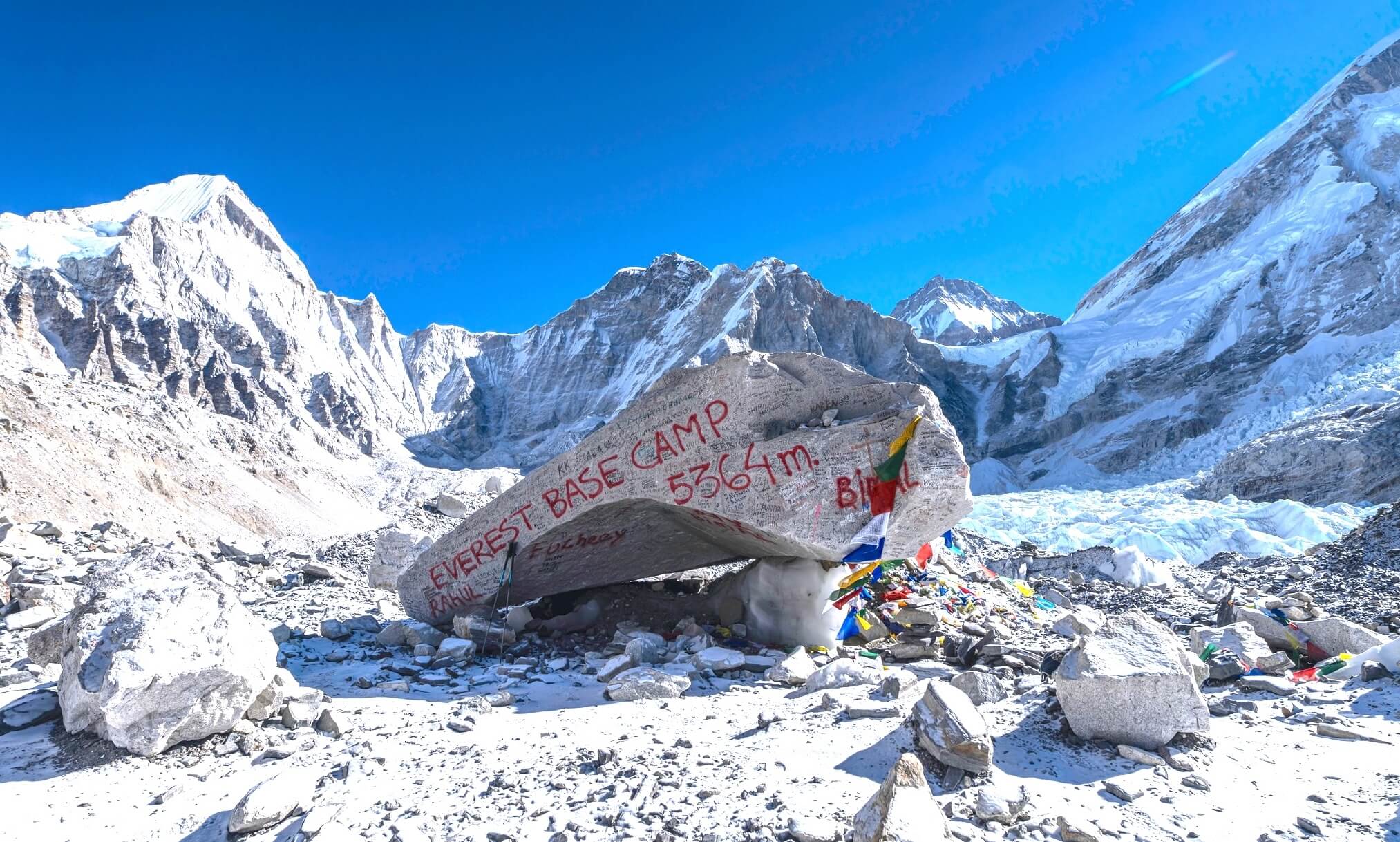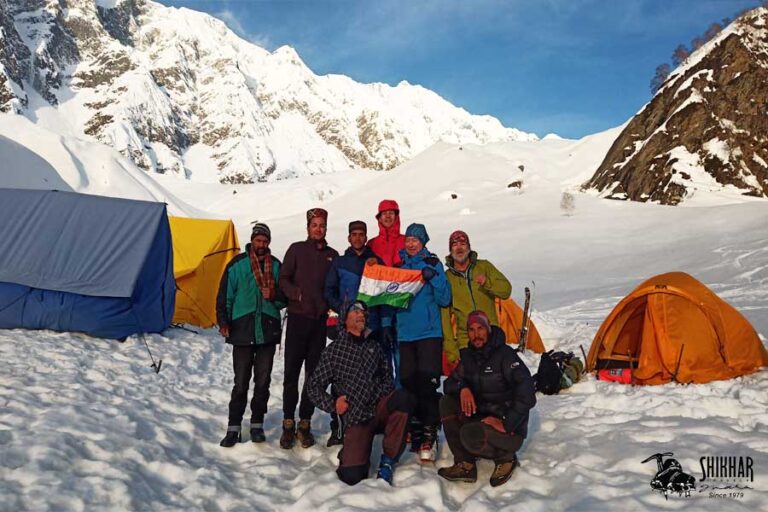
The Everest Base Camp Trek: A Journey with Expert Sherpa Guides Embarking on the Everest Base Camp trek with expert Sherpa guides is an unforgettable journey, one that combines physical challenge, stunning natural beauty, and cultural immersion. Your adventure begins when you leave Kathmandu and fly to Lukla, the gateway to the Everest region. From the moment you take that first step, your Sherpa guide transforms from just another tour guide into a critical member of your journey, both navigating the rough terrain and keeping you safe. With unrivaled knowledge of the environment, weather, and altitude conditions, this level of expertise means it’s possible to navigate treks through some of the world’s most stunning scenery.
The trek is physically difficult and will push you to your limit. The trail winds through scenic Sherpa villages, thick forests, and alpine pastures before reaching the stark rocky landscape closer to Everest Base Camp. Every day has its own challenges, from the steep climbs, the unpredictable weather, and the thinning air as you ascend deeper into the Himalayas. Along with preparing basecamp facilities and food, Sherpas also are responsible for the most important task of the trek: monitoring your acclimatization process by pacing your ascent and planning rest days to prevent altitude sickness.
Along the way, your sherpa guide will also provide glimpses into the region’s rich culture, pointing out Buddhist monasteries, prayer flags, and ancient practices that are inextricably linked to the sherpa way of life. It makes the physical journey much more authentic as you connect to the local traditions and spiritual beliefs of the people.
You will be rewarded with spectacular views of Mount Everest, the Khumbu Icefall, and surrounding peaks at Everest Base Camp. Standing at this hallowed place with your Sherpa guide by your side is incredibly powerful — and because your guide is there with you, this journey is safe, fulfilling, and deeply meaningful, all at the same time. A trek with Sherpas guarantees a well-rounded adventure, mixing culture and a profound reverence for the stunning Himalayas.
Know of the world-famous treks and climbing with professional Sherpas.
One of the best ways to ensure that your adventure of a lifetime, trekking to Everest Base Camp is safe, enjoyable, and memorable is by trekking with expert Sherpa guides. But Sherpas aren’t just expert trekkers — they are key to your success on the trail. Sherpas are known for their strength, endurance, and familiarity with the harsh landscape, making them an unrivaled resource on the trek. They have years of experience in the Himalayan terrain, so they know how to navigate the challenging geography, keep you safe at higher altitudes, and provide valuable insights into the culture as you go. A Sherpa guide’s duties go beyond finding the way—they provide an emotional touchstone, lift morale, and help trekkers keep pace as they adapt to the challenges of the journey. Trekking with Sherpas also makes the experience safer but more enriching — they are the gatekeepers to understanding the history, traditions, and spiritual significance of the Everest region. They are local heroes who enable the arduous trek to Everest Base Camp for trekkers coming from far and wide, helping each of us experience the grandeur of the Himalayas in the flesh. And with a full itinerary planned out by your sherpa, your ultimate Everest trek is no longer just a strenuous physical challenge, but rather a re-direction of your life path — one that will lead to new personal insights for sure.
Meet Your Sherpa Guides: Who Are They And Why Do They Matter?
The Everest Base Camp trek is all about Sherpa guides, and this role cannot be understated. Sherpas are an ethnic group from Nepal’s Khumbu region, known for their extraordinary stamina, strength, and experience with high-altitude trekking. Traditionally, Sherpas have_ been_ the foundation for expeditions in the Everest area, providing his or her intimate knowledge of the terrain and methods_[for those] climbing to the highest point in the world. But that role as a guide goes well beyond that. Sherpas are experienced, friendly, and highly trained people who are with you from start to finish and ensure a successful trip. Not only do they direct trekkers along the safest and most efficient path, but they also help manage other challenges associated with high-altitude trekking like acclimatization and altitude sickness. They are trained in first aid and emergency response, keeping trekkers safe at all times. On top of everything else, the Sherpas provide cultural context and historical insight, explaining aspects of the region’s Buddhist traditions, the history of Everest expeditions, and local customs. Experiencing the mountains in the company of a Sherpa guide is a special treat, even more so when you learn just how deeply rooted their lives are in the mountains, their warmth and knowledge adding to the entire trekking experience. Their constant support alongside the smooth operation of your journey makes them an inimitable part of your adventure to the body of Mount Everest.
The Trekking Route: What to Expect at Each Stage
The Everest Trek covers approximately 130 kilometers (80 miles) and is done in several legs, each of which is unique in its challenges and experiences. It starts with an epic flight to Lukla from Kathmandu, where the adventure gets underway. The initial leg carries trekkers from Lukla to the village of Phakding, through verdant woods and tranquil hamlets. Next on the itinerary is Namche Bazaar, a thriving Sherpa market center and critical acclimatization stop that offers stunning views of Everest. The next leg of the trek leads from Namche to Tengboche, which is home to the iconic Tengboche Monastery, and on to Dingboche, where trekkers are met with views of Mount Makalu. After Dingboche, the trek opens up to Lobuche, a scenic halt around the Khumbu Glacier. There is a final slight push from Gorak Shep to Everest Base Camp, and here after a short rest, trekkers can sit in front of the Base Camp known to them. The track provides more and more stunning views of Everest and surrounding peaks, and each stop is a chance to acclimatize. Along with impressive, snow-capped peaks, the trek also takes in Sherpa villages, monasteries, and memorials to deceased climbers. The trekking route is physically rigorous, but, with the right training and guidance from a Sherpa, it’s a fulfilling and transformative experience.
What a Day in the Life on the Trek Is Like
The Everest Trek Guide is one such adventure, you will be put through, taking life one step at a time, with a wealth of physical challenges, stunning views, and cultural exploration. Typically, mornings begin early and go straight to a hot breakfast before sunrise, which is imperative for fueling the day ahead. The first half of the day typically includes a few hours of hiking, as the trail becomes progressively steeper with the elevation. On the trek, trekkers are joined by Sherpas, who guide them through villages, forests, and rocky terrain, offering nuggets of wisdom and encouragement along the way. After hiking for a few hours, the group typically breaks for a hearty lunch, often in one of the small teahouses that line the trail. The afternoon is spent walking some more toward the day’s destination, stopping occasionally to rest, hydrate , and soak in the scenery. Shortly before late afternoon, the team reaches that day’s stopover — usually a teahouse or lodge where trekkers spend the night and recharge. Most evenings feature a group dinner where hikers mingle with another group, swap stories, and have a good time. Acclimatization days are one of the most important routines put in place alongside the trek to allow trekkers to adjust to the different altitudes. These days usually include short hikes to higher altitudes, followed by the camping party’s descent back to the lower altitude to sleep, helping the body adjust to the thinner air. Overall, daily life on the pilgrimage is about overcoming difficulties while marveling at the spectacular beauty and spiritual significance of the Himalayas.
Chronicles of change: Learning to adapt your body to the higher with your sherpas
It is essential to acclimatize properly in this trek to Everest Base Camp, and your sherpa guides assist you in acclimatizing to the high altitude. Making it to Everest Base Camp requires climbing to 5,364 meters (17,598 feet) where there’s less oxygen in the air, making acclimatization crucial to avoiding altitude sickness. Sherpas know the symptoms of altitude sickness and draw on their rich experience to help trekkers ascend slowly and without risk. One of the main strategies for acclimatization is to “climb high, sleep low.” Trekkers will spend some days hiking up to a higher altitude during the day, then coming down to sleep at a lower elevation, giving the body time to acclimatize to the changing conditions. This slow ascent plus adequate rest, hydration, and nutrition, keep trekkers avoiding altitude-related concerns. Sherpas are constantly on the lookout for signs of altitude sickness in trekkers, including headaches, dizziness , and nausea. If needed, they can suggest slower pacing, extra rest days, or even a descent to lower altitudes. Sherpas know the process of acclimatization not only physically, but mentally as well. This unwavering support, encouragement, and knowledge provide a smoother and safer transition to the effects of the high-altitude environment, allowing trekkers to enjoy the adventure without stressing over their health.
Why Are Travel Insurance and Sherpas Important?
With physical preparation comes mental readiness, and Sherpas are the guardians of the safety of trekkers on the trail up to Everest Base Camp. High-altitude trekking poses the risk of altitude sickness, severe weather extremes, and difficult terrain. Sherpas are trained to notice altitude sickness symptoms early on and know how to reduce these risks, telling trekkers to take a rest, descend, if needed, or slow the pace. They are also responsible for ensuring that trekkers are hydrated, fed, and given the rest they need to meet the challenges of the trek. Furthermore, sherpas are well-equipped with basic first-aid knowledge and can handle emergencies effectively if required. They know the lay of the land and how the weather will affect it — when it’s time to keep trekking and when it’s time to stage a retreat before conditions turn treacherous, like in the case of snowstorms or spots in the trail where the ground is too unstable. Besides making sure on a technical basis that everything runs smoothly, Sherpas are also motivators, pushing trekkers to maintain a positive mindset throughout the physically demanding parts of the trek. They are always around and give continuous assurance to the trekkers that they keep the trekkers motivated to overcome the hardships of the Everest Base Camp Trek. Sherpas not only carry the baggage but also provide a safe and nice environment for the trekkers so that they can succeed in the journey and feel good.
Cultural Insights: Lessons from Sherpas and Local Communities
The EBC with Kala Patthar not only presents a great challenge but also provides a chance to discover the rich culture and traditions of the Sherpa people. Sherpas, the indigenous people of the Khumbu region, have lived in the high Himalayas for centuries, and their culture is intimately enmeshed with the mountains. During one of your many treks, your Sherpa guide will explain the spirituality and culture of the region, the monasteries, prayer flags, and unique practices of Buddhist life that bring so much to the lives of the local people.
Sherpas have an inherently different knowledge of their environment and a deep reverence for the mountains that they consider sacred. They will tell stories about the history of the region, the spiritual practices, and the difficulties faced by their ancestors. This profound cultural link adds a layer to your trek that is about more than just a physical challenge. As you trek through Sherpa settlements, such as Namche Bazaar, Tengboche, and Dingboche, you can expect to witness the loyalty of the villages and learn about the day-to-day lives, customs, and rituals of the locals. Staying in teahouses, many of which are family-run, provides trekkers with an authentic glimpse into daily Sherpa life. Such interactions go a long way in bringing travelers and local communities together, making the trek a holistic and enriching experience, rather than just a physical journey.
“By the end of your trek, you’ll have a profound appreciation for the Sherpas’ way of life, spirituality, and resilience, so your Everest Base Camp trek to the highest point in the world isn’t just an adventure — it’s a cultural exploration, too.”
Sticking with It: Preparations Physical and Mental
Everest Base Camp Trekking is a fascinating experience that one needs to be physically and mentally prepared for. The high-altitude environment, rugged terrain, and daily rigorous hikes challenge trekkers mentally and emotionally, offering lessons that go beyond the physical aspects of hiking. It lasts before the best preparation, which you have to get into good physical shape, that can be done. Cardiovascular conditioning with things like hiking, running or cycling will also help build the stamina you need for long days on the trail. Leg and core strength, along with flexibility training, will serve you well (and need) on the technical, rocky terrain that must be traversed going up to Base Camp.
Preparing mentally is as essential as being physically prepared. The hike is long, sometimes grueling , and taxing on the mind, even more so when altitude sickness starts to set in. It’s not unusual for trekkers to have bouts of fatigue, doubt, or frustration along the way. Mentally preparing means having realistic expectations, being patient with how you progress, and maintaining a positive attitude when the going gets tough. Acclimatization is vital to avoiding altitude sickness, and your Sherpa guides will assist in you making sure you ascend gradually and rest when required.
Adapting to the environment is one of the main challenges — the weather can shift quickly and the rugged terrain requires concentration and meticulous navigation. You never know when you need to go with the flow. Training your body and your mind to work together will lead you to be ready for the obstacles ahead and have a truly enjoyable journey to Mount Everest Base Camp.
Views to Die For: Spectacular Highlights of the Trek
One of the most beautiful sections of the Everest Base Camp trek itself is the mesmerizing variety of landscapes and views presented to you during the hike. Saturday marks the beginning of this series of breathtaking panoramas, starting the moment you step off the plane in Lukla. The initial portion of the hike features inviting rhododendrons and pine trails. The landscapes change, becoming much more rugged and open, with extended views of the Himalayas in full splendor as you walk up.
En route trekkers explore charming villages like Phakding and Namche Bazaar, nestled among terraced fields and watched over by the region’s lofty peaks. The colorful Sherpa village of Namche Bazaar provides a sweeping view of Everest, Lhotse, and the surrounding peaks. Later, the trek passes by the fabled Tengboche Monastery, not just one of the spiritual highlights of the trek, but also a place with some of the best views you’re likely to see of Everest and its neighboring peaks.
The landscapes become more dramatic as you make your way toward Base Camp, with glaciers, icy rivers, and snow-capped peaks on the horizon. The view of Mount Everest itself — rising high above the surrounding peaks — is the pinnacle of this visual treat. An incredible sight, the Khumbu Icefall, as seen from Base Camp, bearing testament to the overwhelming power and beauty of the Himalayas. With each step, the view through the captivating terrain becomes more visually stunning, which is why the journey to Everest Base Camp is completely encountered.
Everest Base Camp: The Ultimate Destination
In the vastness of the outdoors, reaching the Everest base camp trek is the apex of a long, arduous trek, and nothing feels quite as gratifying as the feeling of accomplishment upon arrival. Days spent walking through villages, alpine meadows, and rugged terrain, standing at the base of the world’s highest mountain is an accomplishment that can’t be put into words. Everest Base Camp — the 5,364-meter (17,598-foot), thronged, mobbed destination of climbers gearing themselves up for their summit attempt of Everest but also the destination of trekkers who came to see the exploits of the Himalayas.
You cannot believe your eyes when you climb up to come to view Base Camp. From here, you will see the stunning view of Mount Everest above all other mountains and the Khumbu Icefall below. The camp is a busy hub for climbers, Sherpas , and trekkers alike. There’s a kinship among those who have made the trek, whether they’re gearing up to the summit of Everest or just gawking at the scenery from Base Camp.
Everest Internal Road: The Everest Internal Road has an especially interesting milestone and a comfort-of-use state, amazing to see because of how common so many rugged trails are. The rigors of the trek, the need to acclimatize and the experience of your Sherpa guides all lead up to making this moment one of the most exhilarating of your life. For many, standing at Everest Base Camp is a dream come true; the conclusion of a journey that will be etched in their memories for eternity.
Sherpas: What They Handle When Emergencies Arise or Health Concerns Advance
Sherpas: The Backbone of Everest Base Camp TrekKe adventure You already know that Sherpas are the backbone of this trek. Their expertise is particularly important when it involves health concerns and emergencies in such a difficult setting. Altitude sickness is one of the major worries of trekkers in high altitudes. Sherpas are trained to spot the initial signs of altitude sickness, which can include everything from headaches and nausea to life-threatening conditions such as high-altitude pulmonary edema (HAPE) or high-altitude cerebral edema (HACE). Their extensive understanding of the region helps them address such matters quickly, enabling trekkers to acclimatize adequately and prevent life-threatening complications.
If an emergency arises, a Sherpa is able to respond quickly in cases of injury or sudden illness. They also get training in first aid and know the best actions to take during an emergency. Their relationships with area medical facilities and ability to traverse the terrain quickly make them priceless in a crisis. The Sherpas are also pivotal in orchestrating helicopter evacuations to lower altitudes for advanced medical attention in the unlikely event of a major emergency on the mountain.
In addition to their technical knowledge, Sherpas provide emotional support during stressful or anxious times. Their professionalism and comforting presence instill a sense of assurance to trekkers because they know that they are in the right hands and they can focus on the trek without having to worry about anything. This also reduces travel risks, ensuring a safer and more enjoyable trekking experience thanks to the work of Sherpas handling health and emergencies.
In Conclusion: The Making Trekkers Exciting Indefinable Experience of trekking with professional Sherpas
Everest Base Camp trek with local Sherpa guides who are professional, friendly and have trekked the area you are about to embark on – this trip will forever change who you are. The Sherpas’ experience with the terrain and the knowledge they impart throughout the journey adds a level of depth to the experience that treks through the land wouldn’t have without local representation. Sherpas are not just guides, but cultural ambassadors and introduce trekkers to the spiritual practices, traditions, and way of life of the Khumbu region.
From the physicality of the trek to the mental aspects of pushing through the pain, all are made so much easier with the help of the Sherpas, who are themselves experts on making it to the top. Their knowledge of altitude acclimatization, local conditions, and emergency preparedness allows for a safer and more pleasant experience. The diverse range of terrains, from fertile valleys to rugged summits, makes the journey through this majestic land a treat for the eyes, while the triumph of reaching Everest Base Camp becomes a memory etched in the minds of trekkers for life.
At the end of the journey, it is much more than a physical challenge that has been accomplished. This turns into a journey of personal and cultural strength, resilient exploration, and understanding. It is this inner and outer development that the Everest Base Camp journey leads you to with Sherpas and your surroundings in the Himalayas. Join Sherpas as you travel to the base of the world’s highest mountain and link your heart and mind to the Himalayan spirit.





